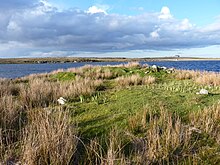Eilean Dhomhnaill
Eilean Dhomhnaill , (also Eilean Domhnuill a Spionnaidh - Ellen Donnell) is a partially artificially created island in Loch Olabhat on the Hebridean island of North Uist . The island was temporarily covered by a prehistoric settlement called Eilean Olabhat or Dun Olavat , the buildings of which have their closest equivalent in those of Knap of Howar on Orkney .
Eilean Olabhat is on the south side of the lake. The island is the earliest evidence of a Crannóg to date, as the radiocarbon dates range from 3650 to 2500 BC. BC, while the much more numerous Irish Crannógs did not appear until the Middle Bronze Age ( Ballinderry 1200–600 BC). The settlement, also known as Dun , has a long and complex history; extensive excavations in the late 1980s have revealed 12 phases, as well as unexplored early phases.
Settlement began when the water level in the lake was much lower than it is today. It consisted of a series of houses with outbuildings that were always renewed in the same place over a long period of time. The later houses on the island were enclosed by a wood-stone wall and accessed via a wood-earth dam. The subsequent buildings were built of stone or lawn and were rectangular or oval and 5-6 by 3-4 meters in size, accompanied by a number of outbuildings. The interior of the main building was divided. The central focus was defined by a plaster. Large amounts of waste (mainly organic material and ceramics) were removed from the settlement. This accumulation, together with the collapsed buildings, meant that the island grew taller and thus mostly evaded the rising water level of the hole, but was inundated at times.
After some time the water receded, the area was repopulated and a stone dam replaced the wooden dam. This re-occupation took place during the Neolithic Age , but the nature of the buildings changed. After that, the water level of the lake rose again and the place was abandoned during the early Neolithic. This last flooding of the island saved the Neolithic systems from disturbances by the later occupation.
A collection of ceramics made up of around 20,000 pieces was recovered. This includes items from a number of styles such as Unstan Ware , Hebridean Ware, and Plain Bowls. There are also two ceramic objects that have been interpreted as phalluses . In contrast to pottery, the lithic yield was poor and quartz was often used as a substitute for flint and chert .
The excavations on the summit of the promontory show that it was occupied with buildings in the Iron Age and the early Middle Ages . The youngest was a covered building from the 6th to 7th centuries.
literature
- Ian Armit: Scotland's Hidden History. Stroud: Tempus (in association with Historic Scotland), 1998, ISBN 0-7486-6067-4
- Ian Armit: Eilean Domhnuill a Spionnaidh (North Uist parish), early neolithic settlement , Discovery Excav Scot, 1989. p. 70
Web links
- Description Engl.
- Entry on Eilean Dhomhnaill in Canmore, Historic Environment Scotland's database
Coordinates: 57 ° 38 '59.9 " N , 7 ° 27' 20.2" W.

